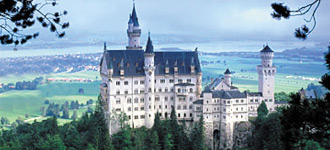Regions of Germany

| Hamburg | Schleswig-Holstein | Berlin |
| Lower Saxony | Frisian Islands | Harz Mountains |
| Hesse | Thuringia | Bavaria |
| Baden-Wurtemberg | Rhineland-Palatinate | North Rhine Westfalia |
Those learning German at Sprachcaffe will come into contact with Germany, a country with a great variety of cultures and landscapes scattered across its different Bundesländer - federal states-. Geographically, Germany is divided into five regions.
The northern lowlands, called the North German Plains, are made up of stretches of flat marshland with moors, lakes and dunes. Off the North Sea coast are several small islands - Frisian Islands and Helgoland- where the Elbe River flows out to sea. The Baltic Sea coast combines flat sandy areas with imposing cliffs and the Holstein Switzerland Peninsula stretches between both seas.
The Central German Uplands mark out the natural border between northern and southern Germany. Here are the Rheinish Uplands, the mountains of Hesse, Weser and the Harz Mountains. Toward the east lies the Bavarian Forest, the Upper Palatinate, Franconia and Thuringian forests and the Metallic Mountains.
The terraced slopes of the mountains in the South East belong to plains of the Upper Rhine region, adjacent to the Black Forest and the Palatinate Forest. The Rhine Valley is wide and is dotted with deep ravines between Bingen and Bonn.
The foothills of the Alps in Southern Germany cover a hilly region with great lakes toward the south, as well as extensive pebble plains. Typical elements found throughout this landscape include the marshy regions and chains of mountains dotted with lakes (Chiemsee, Starnberger See ) and villages.
The German part of the Alps, between Lake Constance and Berchtesgaden, encompasses only a small portion of this mountain system: the Allgäu Alps, the Bavarian Alps and the Berchtesgaden Alps. Picturesque lakes, such as the Königssee ( Lake of the King) together with Berchtesgaden, and other places that tourists flock to such as Garmisch-Partenkirchen or Mittenwald, can all be found embedded in this imposing world of alpine mountains.
Germany has highly interesting cities such as Weimar, Düsseldorf, Hamburg, Cologne, Hannover, Munich, Frankfurt and Berlin, among many others. Berlin once again became the county's capital city and has since reclaimed its place as a renovated European cultural centre.
